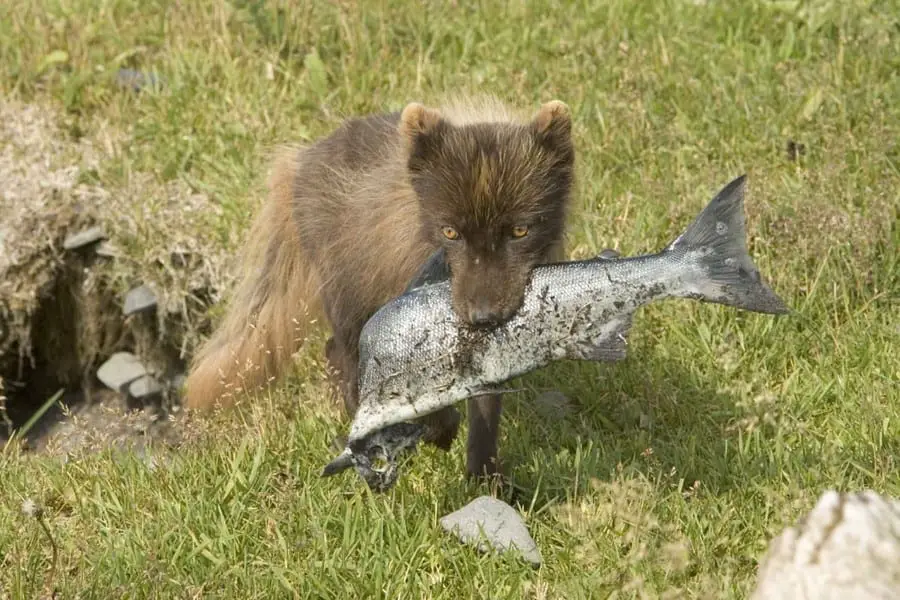It is a popular belief that foxes only feed on rabbits and from trash cans, but they actually eat quite a variety of food. So in this article, we’re going to take a detailed look at what all types of Foxes actually eat, and discuss the food groups and food eaten by foxes through the seasons.
But first, here’s a quick takeaway answer. Then we’ll dive into more detail, as there’s more to it than you might think…
What do foxes eat? Being omnivorous in their feeding habits, foxes eat small mammals, birds, eggs, insects, fish, crabs, worms, reptiles, mollusks, fruits, berries, vegetables, seeds, fungi, and carrion. Fox dietary preferences vary according to the seasons, availability of food, and the species of foxes.
Let’s dive deeper into this topic. You can either play the video below from our Ranger Planet Youtube Channel or continue reading.
Foxes have become successful animals in many environments because they quickly learn to adapt to their environmental surroundings. When we talk about what foxes eat, we’re referring to different fox species, including the following…
- Red fox
- Fennec fox
- Gray fox
- Kit fox
- Arctic fox
Fox Diet
A fox’s diet varies with location and availability of certain foods – according to seasonal changes. Let’s look at each season by season.

Fox diet in Winter
In the winter season, their diet will change and will mostly move away from ground eating and scavenging opportunities due to snow or ice, consisting more of small mammals like mice and rabbits and even rats.
Fox diet in Spring
In spring they will fill their bellies with rodents like mice and earthworms. They even swim into shallow water to hunt fish and crabs.
Fox diet in Summer
In the summer season, foxes need to fatten up while food is plentiful ready for the coming fall and winter months. So they’ll tend to eat large amounts of insects while they’re in abundance at this time of year.
These include beetles, grasshoppers, crickets, general all-around beetles, and even small or large caterpillars as well as targetting small amphibians like frogs and newts.
Fox diet in Fall
During the fall, foxes prefer the now ripening fruit and abundance of available berries like blackberries, raspberries, blueberries, apples, and other fruits like the Asian or Japanese persimmon, plus acorns and tuber vegetables like the yam, potato, and sweet potato.
Find out What Eats a Fox!
Diet of Red Foxes
Of all Fox species, the red fox is the one we associate with most of all. Mainly as they’re the most widely distributed fox species throughout the world.
They’re mainly carnivores but because of their overall variety of food, they’re mostly classified as omnivores.
But for the most part, the red fox mainly feeds on small rodents like mice, rabbits, and voles. But they have been known to feed on birds when they can get them, insects too, and grasshoppers, earthworms, most beetles, plums, apples, blackberries, as well as mollusks, and crayfish in shallow waters.
They will also eat amphibians, any small reptiles they can get, and most types of fish. They’re also known to prey on young lambs and even deer fawns that are more available in the spring.
Fox food intake and hunting
Foxes look to consume about 1 kilogram of food daily in order to maintain their body weight and energy levels, potentially more for pregnant adult females.
Their keen sense of eyesight and hearing helps them locate man types of small mammals in thick grasslands.
They’re also very accomplished hunters, capable of reaching speeds of 31mph, (up to 50km p/h) and they’re agile too – like cats, they can turn sharply, or leap high into the air to ambush prey or traverse obstacles.
Being excellent hunters, foxes generally store their surplus food in shallow holes about 2 – 4 inches (5 – 10 cm) beneath the ground, which they’ll dig out using their front paws.
A bit like squirrels, they might have several of these food hideaways. This means that if one food cache is located by another animal, there are still the remaining food sources stashed away.
These strategies and abilities are the main reasons foxes have been able to adapt successfully for centuries in a wide set of environments, and alongside large human population areas, even deep within the heart of towns and cities.

Rural vs Urban Fox Diets
Human activities and general discarded waste found around and in urban settings inevitably attract rodents like rats and mice.
The urban foxes take full advantage of these freely available and easy food sources and are more likely to find and eat birds like pigeons, or mice and when compared to the rural fox.
People are also known to actively leave food out for local foxes and they’re also likely to scavenge for any pet food that is also left outside
They’ll also feed on bread left for birds, and other food such as seeds left out for birds. And where disposal in bins has emptied out or overflowed, then foxes will happily scavenge for scraps of leftover food in those as well.
Foxes have really diverse diet feeding habits which has helped to sustain their numbers. They’re fantastic hunters preying on rabbits, rodents, and earthworms along with eating carrion.
But they aren’t carnivorous, they are omnivores because they feed on berries and vegetables too. When born, fox cubs are both deaf and blind, and they’re dependent upon their mother’s milk. These cubs start eating solid food at around four weeks old.
Despite the variety of foods they’ll eat, a fox’s diet is mainly composed of meat protein, so the ideal stuff to feed pet foxes are cooked or raw meat or tinned pet food. They also eat peanuts, berries, fruit, and cheese. Foxes can be fed all year round.
Pet foxes typically eat items similar to what you give your pet dogs and cats to eat. Being omnivores, a balanced diet for a pet fox should also include vitamins, minerals, meat, fruits, and vegetables.
Find Out What Eats a Wolf!

Protein in a fox’s diet
When in the wild and further from urban environments, foxes will hunt and catch small rodents, but as pets, they don’t have to hunt of course.
Instead, you should offer them formulated fox food like these hi-protein ones on amazon. Which contains taurine, as it has almost all the nutrients your pet fox needs along with pre-killed mice, small rats, or pinkies depending on what size your pet fox is.
Fennec foxes usually feed on mice and generally the smaller rodents while the Red Fox or Siberian foxes can eat larger rodents like rats or small rabbits since they’re larger in size as compared to a fennec.
Regardless of the source, the majority of your pet fox’s diet should comprise of protein.
Insects are also a major part of a fox’s diet. In the wild, a lot of a fox’s day is spent scrounging for caterpillars, crickets, grasshoppers, beetles, and even silkworms, along with crayfish and other crustaceans – depending on their location.
You can feed your pet fox a few dozen mealworms too, or crickets, or larger insects since these are also easily available from typical pet stores.
Some fox owners also choose to feed raw meat to their pets, but there are mixed opinions about feeding raw food to pet foxes. In fact, this mixed opinion is applied to almost all pets, such as dogs, cats and the like.
Vegetables in a fox’s diet
Foxes will eat vegetables! In the wild foxes will forage for vegetables, and even dig up potatoes and other root vegetables.
For a pet fox, you can provide them with mixed frozen vegetables, or potatoes and tomatoes as part of their daily diet.
They don’t need much however, smaller foxes need just a palm-sized portion of vegetables a day. Larger foxes require larger hand-sized portions.
Fruit in a fox’s diet
As we said previously, Foxes mainly eat fruits when they come into season – mainly in late summer through fall. So fruit should only be given as treats, not as a staple like vegetables.
Foxes are especially fond of most edible berries and many fox owners actually like to feed them sweet fruits and cherries to their pet fox as treats because it helps negate the foul odor of their urine.
Excess of any fruit is not healthy for a fox, in the wild they’ll regulate their own fruit intake, but for pet foxes, just be cautious not to overfeed them with raisins and grapes as an excess of these are known to cause kidney damage in foxes.
Grains in a fox diet
Foxes do not like wheat, oats or rice, so avoid feeding any of these to Foxes. and in fact, other grain type foods because foxes don’t consume any grains in the wild.
A large portion of carbohydrates for Foxes comes from the mice and other rodents they feed upon. The remaining carbohydrates they generally get from the fruits and vegetables they consume.
Vitamins and supplements in a fox diet
In the wild, foxes get a healthy balance of foods so all their supplements are generally taken care of.
Taurine is a chemical supplement that’s necessary for many animals and pets, and foxes need it too. it’s usually found in fortified fox diets or grain-free dog foods. If it isn’t already present as an ingredient in what the fox is eating, then you can consult your local vet and supplement it with taurine capsules.
Smaller foxes need approximately 500 milligrams of taurine a day while larger foxes need more.
Most of the vitamins and minerals that any fox needs as a pet is already present in any grain-free food you feed it. The rest of it will be there in their general diet of rodents, insects, and vegetables – on a daily basis.
Learning Resources
If you wish to learn more about these most fascinating and adaptable creatures, at home, at school or homeschooling, then explore the resources we’ve found on amazon below…
Flows with story-like content that describes the various fox species, habitat, facts, and what it’s like to be a fox pup!
Great for 1st to 2nd graders, this book introduces foxes and their young, it describes their physical characteristics, habitat, life cycle, their caring behavior to their young, and differences from other similar animals.
To finish up…
We hope this has been useful in understanding what a fox eats, in the wild but also if you intend to have a fox as a pet! If you have anything to add we’d love to hear it in the comments below.
This content has been checked and verified by a qualified veterinary practitioner. The article has been reviewed by our editorial board and has been approved for publication in accordance with our editorial policy.
